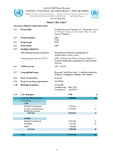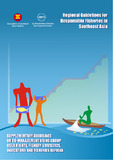| dc.description.abstract | The South China Sea is a global centre of shallow water marine biological diversity that supports significant fisheries that are important to the food security and export income of Southeast Asian countries. These fisheries are characterised by high levels of fishing effort from the small-scale sector. Accordingly, all inshore waters of the South China Sea basin are subject to intense fishing pressure. This situation of high small-scale fishing pressure and declining fisheries resources has contributed to the adoption of unsustainable fishing methods to maintain catch and increase incomes in the short-term. These include the use of destructive fishing gear and practices, such as the operation of demersal trawls and push nets in seagrass areas, and the detonation of explosives and release of fish poisons in coral reef areas. Small-scale inshore fishing pressure has therefore been identified as a significant cause of the degradation and loss of coastal habitats in the South China Sea.
Although action aimed at reducing the rate of loss of coastal habitats has been implemented by countries bordering the South China Sea, the decadal rate of loss of such habitats remains high, e.g., seagrass beds (30 percent), mangroves (16 percent), and coral reefs (16 percent). This continued decline in the total area of habitats critical to the life cycles of most aquatic species, combined with the high levels of coastal community dependence on fish, has raised serious concerns for the long-term sustainability of small-scale fisheries in the region. With fish production being intrinsically linked to the quality and area of habitats and the heightened dependence of coastal communities on fish, a need exists to improve the integration of fish habitat considerations and fisheries management in the region. This project entitled “Establishment and Operation of a Regional System of Fisheries Refugia in the South China Sea and Gulf of Thailand” has been developed to meet this need via implementation of the fisheries component of the Strategic Action Programme for the South China Sea. Executed regionally by the Southeast Asian Fisheries Development Center in partnership with the government agencies responsible for fisheries in the 6 participating countries, the project is comprised of the following 4 project components.
Component 1 will result in the establishment of operational management at 14 priority fisheries refugia, with community-based refugia management plans being key outputs. Supporting activities include consultative processes to facilitate agreement among stakeholders on the boundaries of fisheries refugia, identification of key threats to refugia sites, recording of fishing community views regarding appropriate fisheries and habitat management measures, and eliciting stakeholder inputs to management plan review. Refugia management plans will provide rules inter alia on operating requirements for the use of particular classes of fishing vessels or fishing gear within refugia, procedures for adjusting management measures over time, and mechanisms for enforcement. Specific direction is given to drafting of regulations and ordinances required in support of plan implementation.
Component 2 focuses on strengthening the enabling environment for the formal designation and operational management of refugia. Preparatory activities include legal reviews to identify, inter alia: legal terminology for describing refugia; formal procedures for demarcating boundaries of spatial management areas such as refugia, including requirements for assessing the socio-economic impacts of management measures and stakeholder consultation; and provisions for decentralising refugia management to the community level via development of co-management and rights-based approaches. These national reviews are aimed at informing the drafting of required policy and legislative amendments for adoption by competent authorities. This component will also build the national and site-level science and information base required to inform the monitoring and evaluation of the effectiveness of individual refugia and the regional network of sites.
Component 3 focuses on strengthening information management and dissemination aimed at enhancing the national uptake of best practices in integrating fisheries management and biodiversity conservation, and in improving community acceptance of area based approaches to fisheries and coastal environmental management. Supporting activities involve the development of national knowledge management systems on the use of fisheries refugia in capture fisheries management, and the establishment of a Regional Education and Awareness Centre that will operate as a facility for the production and sharing of information and education materials on fisheries and critical habitat linkages in the South China Sea. Importantly, Component 3 will support the development of indicators to monitor the effectiveness of coastal fisheries management systems established for priority fisheries refugia. A regional programme for the compilation of standardised fisheries statistics for use in identifying and managing fisheries refugia will also be developed to support longer-term management.
At the national-level, Component 4 will strengthen cross-sectorial coordination for integrated fisheries and environmental management and will harness the national scientific and technical expertise and knowledge required to inform the policy, legal and institutional reforms for fisheries refugia management in the participating countries. Local community action and strengthened ‘community to cabinet’ linkages will be facilitated via establishment and operation of site-based management boards for fisheries refugia at the 14 priority locations in the South China Sea. Regionally, Component 4 will foster regional cooperation in: the establishment and operation of a regional system of fisheries refugia; and in the integration of scientific knowledge and research outputs with management and policy making. This component also includes project coordination and management activities aimed at: ensuring the timely and cost effective implementation of regional and national-level activities; and satisfying the reporting requirements of UNEP and the GEF.
The longer-term goals of this project are to contribute to: improved integration of habitat and biodiversity conservation considerations in the management of fisheries in the South China Sea and Gulf of Thailand; improved national management of the threats to fish stock and critical habitat linkages within fisheries refugia; and enhanced uptake of good practice in integrating fisheries management and biodiversity conservation in the design and implementation of regional and national fisheries management systems. The medium-term objectives align with those of the fisheries component of the Strategic Action Programme for the South China Sea which are to: build the resilience of Southeast Asian fisheries to the effects of high and increasing levels of fishing effort; improve the understanding among stakeholders, including fisherfolk, scientists, policy-makers, and fisheries managers, of ecosystem and fishery linkages as a basis for integrated fisheries and ecosystem/habitat management; and build the capacity of fisheries departments/ministries to engage in meaningful dialogue with the environment sector regarding the improvement of fisheries and management of interactions between fisheries and critical marine habitats. Related end of project targets are:
• by 2018, to have established a regional system of a minimum of fourteen refugia for the management of priority transboundary, fish stocks and endangered species; and
• by 2018, to have prepared and implemented fisheries management systems in the identified priority refugia based on and consistent with, the ASEAN SEAFDEC Regional Guidelines for Responsible Fisheries in Southeast Asia.
Given the limited integration of the work of fisheries and environment ministries observed in Southeast Asia and many other parts of the world, the establishment and operation of the regional system of fisheries refugia provides an opportunity to learn from a regional fishery sector led initiative to collaborate with the environment sector on integrating fisheries and coastal habitat management. It is anticipated that the experience gained in the South China Sea region through this project will be suitable for application in other marine areas such as the Yellow Sea where over-fishing and the use of inappropriate fishing gear are significant impediments to more sustainable exploitation of fisheries resources and the use of coastal habitats. | en |




